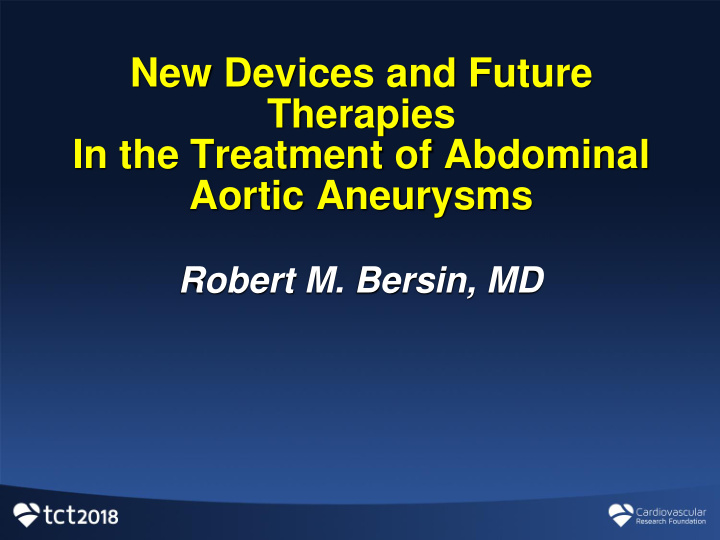



New Devices and Future Therapies In the Treatment of Abdominal Aortic Aneurysms Robert M. Bersin, MD
Disclosure Statement of Financial Interest I, Robert M. Bersin, have a financial interest/arrangement or affiliation with the following organizations that could be perceived as a real or apparent conflict of interest in the context of the subject of this presentation: • Nectero Corporation
High Rate of Continued Sac Enlargement with Current Generation of Endografts D. Böckler LINC 2018
Survival On vs. Off Label EVAR Use 49% had ≥1 IFU deviation A. With and without any instructions for use (IFU) deviation. B. With and without neck IFU deviations. Predictors: Neck length (p = 0.004; OR 1.91) and aneurysm angle (p = 0.006; OR 2.06) Cain BC et al J Vasc Surg 2016; 64(5): 1533
Ovation Global Pivotal Trial No Type I Leaks in Patients With Adverse Neck Anatomy Pre implant Post implant Pre implant Post implant 35% of enrolled patients had 1 or more hostile neck feature (56/161) Mehta M et al J Vasc Surg 2014; 59: 65-73
Ovation On- vs Off-Label Use TriVascular Ovation Italian Study (TOIS) Neck Lengths On-Label ≥7 mm vs. Off-Label <7 mm Type Ia endoleak p = 0.6, NS Re-intervention p = 0.4, NS ≥7 mm neck length requirement removed from IFU de Donato et al J Endovasc Ther 2017; 24(2): 191 – 197
Ovation Alto First sealing ring is 7mm below fabric collar instead of 13 mm ELEVATE IDE trial enrollment complete
EVAS-Endovascular Aneurysm Sealing Carpenter JP et al J Vasc Surg 2016;63:23-31
EVAS Forward Global Registry On- vs. Off-Label Outcomes Freedom from type Ia endoleak Freedom from re-intervention p-value = 0.0066 Type Ia endoleak rate 3.1% on-label vs. 14.4% off-label at 2-years Secondary intervention rate 7.8% on-label vs. 19.3% off-label at 2-years A Holden SVS 2016
Single-arm post-market registry of the Nellix EVAS utilizing chimney grafts 1-year outcomes (N=154) • Type Ia endoleak 4.3% • Type II or III endoleak 0.0% • Re-intervention 10.8% • Aneurysm-related mortality 5.7% Thompson M et al J Endovasc Ther 2017: 24(6): 764 – 772
Altura Double D Endograft FIH and ELEVATE Registry 1-Year Results (N=90) Clinical Success 99.0% Aneurysm-related mortality 0.0% Type I endoleak 1.1% Re-intervention rate 6.7% CE Marked 2017 ALTITUDE Global Registry (N=1000) initiated 2018 Kreivins D et al J Endovasc Ther 2018; 25(3): 379-386
Endovascular Aneurysm Stabilization Therapy
Pathophysiology of Aneurysm Formation • Atherosclerosis is associated with chronic inflammation of the aortic wall • With inflammation, vascular smooth muscle cells (VSMCs) and infiltrating macrophages release metalloproteinases, principally MMP-2, MMP-7, MMP-9 and MMP-12 (also known as human macrophage elastase or HME) • MMP-9 and MMP-12 are the metalloproteinases most responsible for loss of extracellular matrix components, especially elastin in atherosclerotic tissues Healthy Aortic Tissue Diseased Aortic Tissue
Pathophysiology of Aneurysm Formation • Elevation of tissue elastase levels appears to be a key factor in aneurysm formation • Collagenase levels have not correlated with aneurysm formation 24 patients with atherosclerosis of the aorta Aneurysm (8) Occlusive (16) P value Aortic wall elastase 8.211 3.049 0.0030 (nmol/gr tissue) (3.408-14.205) (0.000-5.636 Aortic wall elastase 2.303 0.559 0.0018 (nmol/gr protein) (0.616-5.171) (0.000-1.345) Samy AK et al 1994; J Vasc Endovasc Surg 28(5): 311-317
EAST Polymer Binds With Elastin to Prevent Degradation by Elastase • EAST polymer binds with elastin making it resistant to enzymatic degradation by elastase and other enzymes • Binding is durable, not easily reversed • Stabilization of elastin increases tissue strength and resistance to stretch • Stabilization of tissue elastin results in aneurysm stabilization EAST Polymer Elastase Elastin X
EAST Polymer Delivered Via Aavert ™ Coated Balloon • Ultra-compliant polymer-coated balloon gently conforms to diseased vessel segment Expands to 5+ cm, covers irregular anatomy Pressure is greater than blood but less than 1 atm Balloon dimples at side vessels, demonstrating compliance • Hydrophobic polymer transfers to tissue in 3 min • Minimally invasive, 30 minute procedure 10 FR catheter delivery Outpatient procedure
Intraluminal Delivery of EAST Polymer Prevents AAA Formation EAS T A. Balloon dilation plus elastase B. Balloon dilation plus elastase plus EAST polymer C. Control group (sham procedure) Kloster, B et al Ann Med and Surg 2016; 7: 65-70
Intraluminal Delivery of EAST Polymer Promotes AAA Regression AAA pre-treatment Regression with EAST polymer
EAST Polymer Increases Human Aortic Tissue Strength EAST EAST solution
Conclusions • Rate of continued sac enlargement remains high with the current generation of endografts • Off-label use of endografts is associated with more sac enlargement, more secondary interventions and a higher mortality • Most common cause is adverse neck anatomy • Next generation devices are focusing on sealing short, angulated necks with polymeric and/or “Double D” designs • Aneurysm stabilization technologies hold promise to arrest aneurysm growth and obviate the need for repair 21
Recommend
More recommend